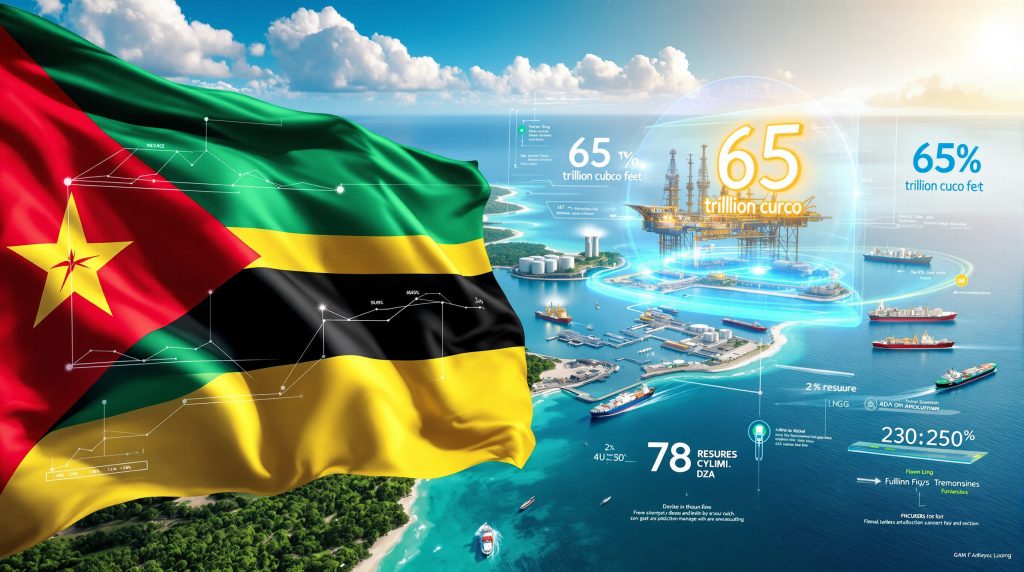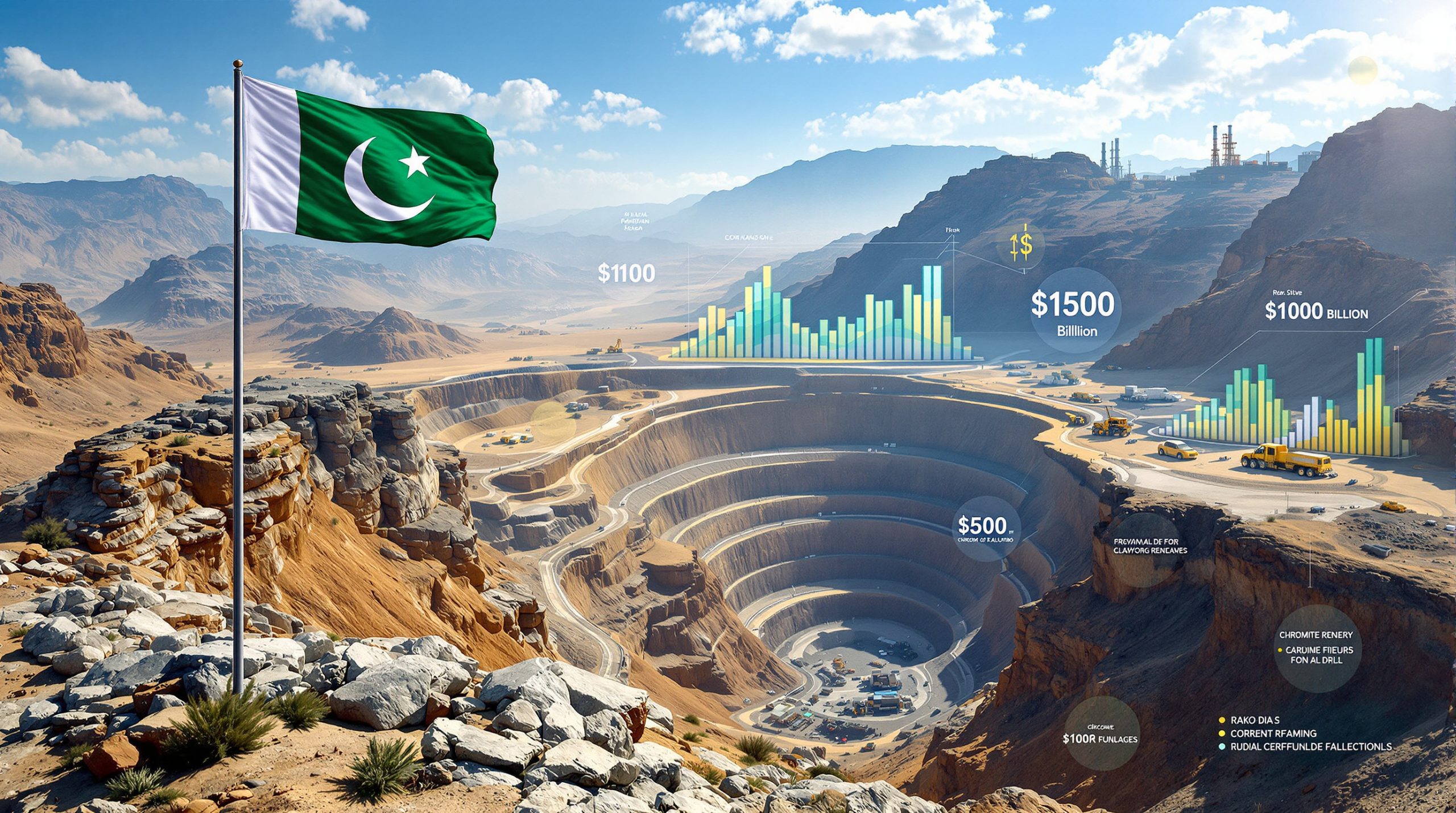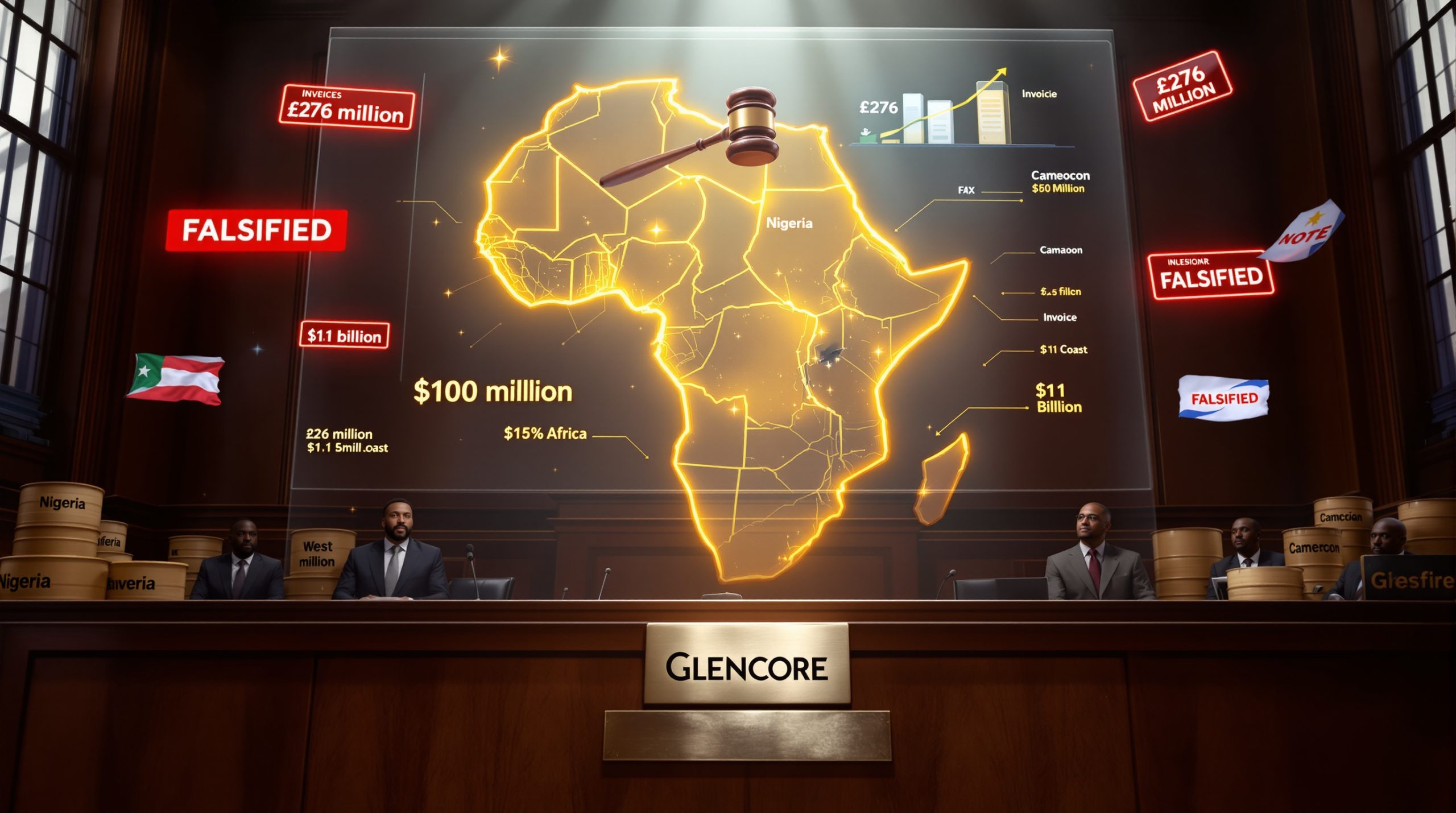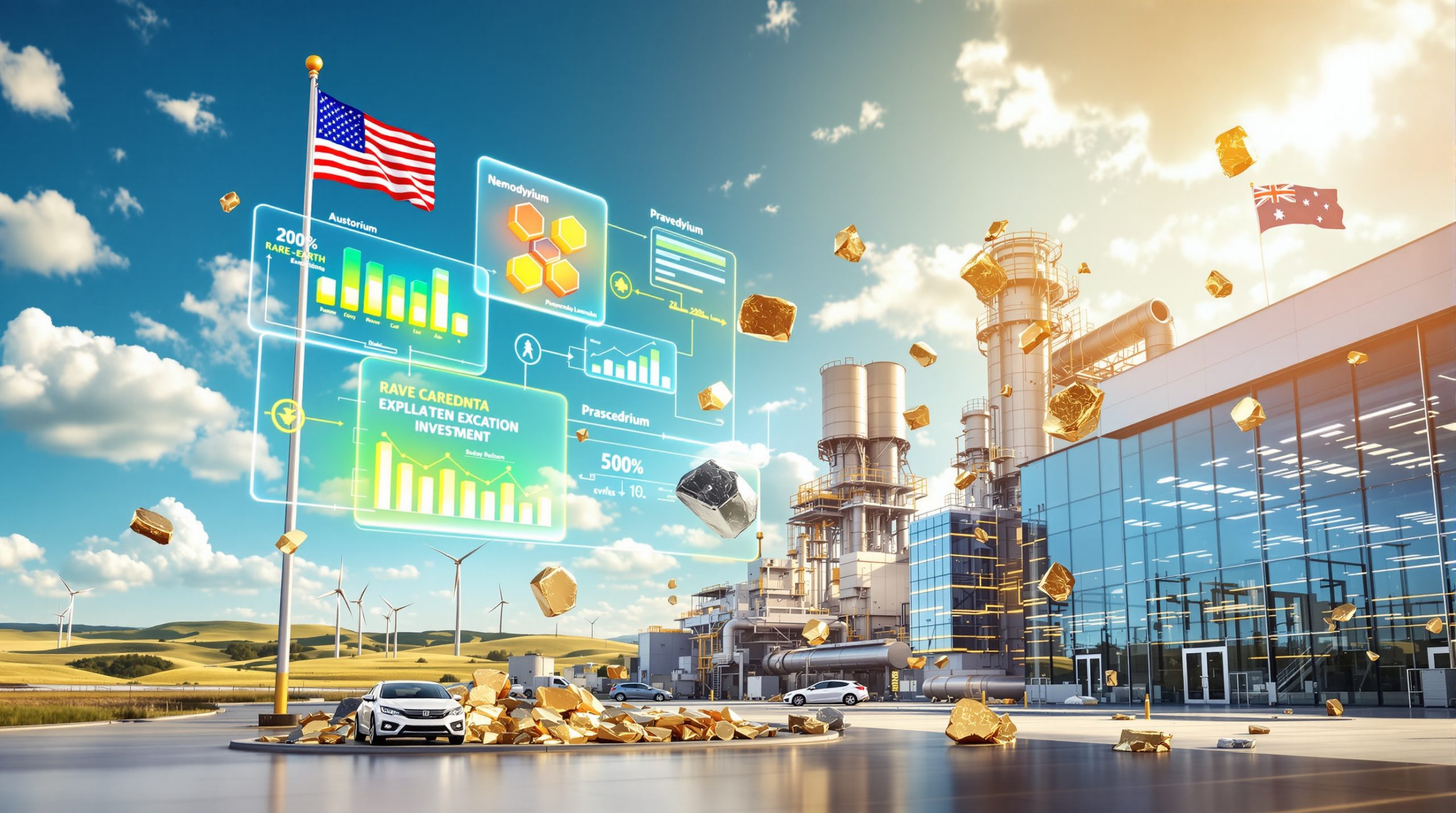TotalEnergies' $20.5 billion Mozambique LNG project represents one of Africa's most ambitious energy infrastructure developments, targeting vast offshore natural gas reserves in the Rovuma Basin. This transformative undertaking could reshape both regional economics and global energy markets, positioning Mozambique as a major LNG supplier to growing Asian and European markets.
Discovered reserves exceed 65 trillion cubic feet of recoverable natural gas, establishing Mozambique among the world's most significant resource holders. The scale of these discoveries has attracted billions in foreign investment and established the foundation for decades of production capability that could supply international demand for cleaner-burning fossil fuels.
What Is the Mozambique LNG Project and Why Does It Matter?
The Mozambique LNG project encompasses multiple liquefied natural gas developments operated by international energy giants, including TotalEnergies and ExxonMobil's Rovuma LNG project. Initial phases target processing capacity of approximately 13 million tonnes per annum, with expansion potential reaching 43 million tonnes across multiple operational phases.
Key infrastructure components include offshore extraction platforms in the Golfinho and Atum deepwater fields, connected via a 40-kilometer subsea pipeline to onshore processing facilities. Advanced liquefaction trains utilise proven cryogenic technology, whilst purpose-built marine terminals accommodate large LNG carrier vessels through specialised loading systems.
The modular design approach enables phased development expansion based on market demand and reserve assessment updates. This flexibility provides operators with strategic options for capacity scaling whilst managing capital investment timing and risk exposure effectively.
Strategic Importance for Global Energy Markets
Mozambique's geographic positioning offers significant logistical advantages for serving Asian energy markets, particularly Japan, South Korea, and emerging Southeast Asian economies experiencing rapid natural gas demand growth. Shorter shipping routes compared to traditional suppliers create competitive advantages in delivered costs and supply reliability.
Furthermore, the US Natural Gas Forecast indicates evolving market dynamics that could benefit alternative suppliers. The project also contributes to European energy security objectives by providing alternative supply sources that reduce dependence on traditional pipeline gas imports.
This diversification proves increasingly valuable as European nations prioritise supply chain resilience and energy independence strategies, particularly in light of ongoing geopolitical tensions affecting traditional energy relationships.
How Did Security Challenges Impact Project Development?
Security concerns fundamentally altered the trajectory of Mozambique LNG development, creating unprecedented challenges for international energy operators working in the region. The evolution from initial optimism to crisis management illustrates the complex intersection between resource development and regional stability requirements.
The 2021 Security Crisis
Islamic State-linked militant attacks on Palma town in northeast Mozambique during 2021 triggered immediate project suspensions across multiple developments. The violence created an operational environment where international contractors could not safely execute construction activities or maintain personnel presence in the affected regions.
Both TotalEnergies and ExxonMobil implemented force majeure provisions, legally suspending contractual obligations due to circumstances beyond their control. According to recent reporting from November 2024, ExxonMobil CEO Darren Woods indicated the company expects to lift force majeure in the very near future, marking a potential turning point for project advancement.
The attacks displaced thousands of local residents and highlighted fundamental security infrastructure gaps in the Cabo Delgado region. International operators faced the challenge of protecting extensive offshore and onshore assets whilst ensuring personnel safety across geographically dispersed operations.
Economic Consequences of Delays
Extended project suspensions created cascading financial impacts affecting operator budgets, contractor schedules, and investor confidence. Additionally, these delays occurred alongside broader market disruptions, including oil price movements that complicated investment planning across the energy sector.
| Impact Category | Financial Effect |
|---|---|
| Additional Costs | $4.5 billion increase |
| Timeline Extension | 5-year delay in first production |
| Revised Budget | $20.5 billion total investment |
| Market Entry | Pushed to H1 2029 |
The delays forced operators to maintain project teams and equipment whilst generating no revenue, creating substantial carrying costs. Contract renegotiations with suppliers and service providers became necessary to address extended timelines and changed operational requirements.
Market entry delays also affected long-term supply contracts with international buyers, requiring schedule adjustments and potentially impacting negotiated pricing terms. The uncertainty surrounding project restart timing complicated financing arrangements and investor relations management.
Security Improvements and Risk Mitigation
International military assistance, including Rwandan force deployment, has contributed to stabilising operational conditions in the affected regions. These interventions established protected zones around critical infrastructure and created conditions enabling gradual project resumption.
Comprehensive security protocols now encompass enhanced surveillance systems covering offshore platforms and onshore facilities, protected transportation corridors for personnel and equipment movement, and coordinated intelligence sharing between government and private security forces.
The security framework requires ongoing investment and coordination between multiple stakeholders, including Mozambican government forces, international military partners, and private security contractors. This multilayered approach addresses both immediate operational protection needs and longer-term regional stability objectives.
Who Are the Key Players Behind Mozambique LNG?
The Mozambique LNG project involves a complex network of international energy companies, financial institutions, and technical contractors working together to develop these massive offshore gas resources. Understanding the key stakeholders provides insight into project dynamics and decision-making processes.
Primary Operators and Ownership Structure
TotalEnergies SE serves as the primary operator with a 26.5% stake, bringing extensive deepwater expertise and global LNG marketing capabilities. The French energy giant oversees day-to-day operations, technical coordination, and regulatory compliance across the development phases.
Mitsui & Co provides significant financial backing whilst offering crucial access to Asian energy markets, particularly Japan's substantial natural gas import requirements. This Japanese trading house connection ensures established marketing channels and long-term supply contract opportunities.
Empresa Nacional de Hidrocarbonetos (ENH), Mozambique's national oil company, maintains strategic government representation within the consortium. This participation ensures local interests are considered in project decisions whilst providing the government with direct involvement in resource development.
ExxonMobil operates a separate but complementary development called Rovuma LNG, which targets nearby reserves in the same basin. According to November 2024 statements from CEO Darren Woods, the company expects to advance fairly quickly with final investment decisions once force majeure provisions are lifted.
International Partnership Network
The consortium structure reflects global demand patterns for liquefied natural gas, with participation from Indian state enterprises providing market access to South Asia's growing energy sector, Thai national energy companies connecting to Southeast Asian demand centres, and various financial institutions offering project financing and risk management.
This diverse ownership structure distributes both financial risk and revenue potential across different economic regions, creating stability through geographic diversification. However, the international partnership network must also navigate complex trade dynamics, including potential investment market tariffs that could affect project economics.
Technical Contractors and Expertise
TechnipFMC handles sophisticated subsea installations, bringing proven experience in deepwater completion systems and underwater pipeline networks. Their technical capabilities encompass the complex engineering requirements for connecting offshore wells to onshore processing facilities.
Van Oord and Allseas manage marine construction phases, including heavy-lift operations and specialised vessel deployment. These Dutch and Swiss contractors provide unique capabilities for offshore infrastructure installation in challenging deepwater environments.
Worley delivers comprehensive project management and engineering design services throughout the development lifecycle. The Australian engineering firm coordinates technical integration between offshore and onshore systems whilst ensuring compliance with international safety standards.
What Are the Technical Specifications of Mozambique LNG?
The technical complexity of the Mozambique LNG project encompasses sophisticated offshore extraction systems, advanced processing technology, and purpose-built export infrastructure designed to handle massive natural gas volumes over decades of operation.
Offshore Extraction Infrastructure
The Golfinho and Atum fields require cutting-edge subsea completion systems capable of operating in deepwater environments exceeding 1,000 metres depth. Advanced drilling techniques access gas reserves located several thousand metres beneath the seabed, utilising directional drilling to maximise resource recovery from multiple reservoir zones.
Production flows through a comprehensive 40-kilometer subsea pipeline system connecting offshore wellheads to onshore processing facilities. This underwater infrastructure incorporates multi-phase flow lines handling gas, condensate, and produced water, alongside subsea manifolds distributing production from multiple wells.
The subsea architecture enables simultaneous production from multiple reservoir zones whilst providing operational flexibility for field optimisation and maintenance activities. Sophisticated monitoring systems track pipeline integrity and production performance in real-time.
Liquefaction Technology and Processing Capacity
State-of-the-art liquefaction trains convert natural gas into transportable LNG through proven cryogenic processes reaching temperatures of -162°C. The modular design approach enables phased capacity expansion as market demand grows and additional reserves are developed.
Each processing train incorporates gas treatment systems removing impurities and water content, compression stages preparing gas for refrigeration cycles, and heat exchangers managing thermal energy throughout the cooling process. Modern processing technology includes carbon capture capabilities and efficiency improvements that reduce greenhouse gas emissions compared to legacy facilities.
Export Terminal and Loading Facilities
Purpose-built marine terminals accommodate the world's largest LNG carriers, featuring specialised infrastructure for safe and efficient cargo operations. The facility design supports simultaneous loading operations whilst maintaining strict safety standards for handling cryogenic liquids.
Terminal infrastructure encompasses multiple cryogenic storage tanks, specialised loading arms for transfer systems, berth configurations accommodating large vessels, and comprehensive safety systems with emergency shutdown capabilities. The loading facility design incorporates advanced vapour return systems, automated transfer controls, and comprehensive safety monitoring to ensure operational reliability.
How Will Mozambique LNG Transform the Country's Economy?
The economic transformation potential of Mozambique LNG extends far beyond direct project revenues, encompassing infrastructure development, human capital formation, and regional economic integration that could reshape the country's development trajectory.
Revenue Generation and Government Income
Natural gas exports represent the largest foreign exchange earning opportunity in Mozambique's history, with potential for billions in annual revenue once full production capacity is achieved. Government income streams include corporate taxes, royalty payments, and profit-sharing arrangements that could significantly expand public sector resources.
The revenue structure provides multiple benefit mechanisms, including direct taxation on operator profits and contractor services, royalty payments based on production volumes and commodity prices, and export duties generating foreign currency earnings. Economic modelling suggests potential GDP increases of several percentage points annually once full production is achieved.
These projections provide resources for addressing infrastructure deficits, education system improvements, and healthcare capacity expansion across Mozambique's provinces. However, revenue realisation depends on successfully navigating global market conditions and maintaining operational security.
Employment Creation and Skills Development
The project generates extensive employment opportunities spanning construction, operations, and supporting service industries. Direct employment encompasses thousands of positions across technical, professional, and manual labour categories during different development phases.
Employment creation includes construction phase requirements for peak workforces exceeding 10,000 personnel, operations phase provision of permanent employment for specialised technical roles, and indirect employment across transportation, catering, accommodation, and maintenance services.
Skills development initiatives focus on building technical capabilities within Mozambique's workforce, creating career progression pathways from entry-level positions to supervisory and management roles. These programs address both immediate project needs and long-term economic diversification objectives.
Infrastructure Development Benefits
Large-scale energy development necessitates substantial infrastructure investments that provide benefits extending far beyond project operations. These improvements address regional development needs whilst supporting broader economic activity.
Major infrastructure enhancements include modern port facilities enabling increased international trade capacity, enhanced transportation networks connecting previously isolated regions to national highway systems, and upgraded telecommunications infrastructure providing digital connectivity essential for economic modernisation.
The infrastructure development creates multiplier effects throughout the regional economy, enabling new business opportunities and improving quality of life indicators across northern Mozambique's provinces.
What Challenges Still Face the Mozambique LNG Project?
Despite significant progress toward project resumption, multiple challenges continue influencing development timelines, operational costs, and long-term success prospects. Understanding these ongoing issues provides realistic assessment of project risks and implementation complexity.
Ongoing Security Concerns
Whilst security conditions have improved since international military intervention, insurgent activity remains a persistent concern requiring continuous vigilance and resource allocation. The operational environment demands sophisticated security protocols that add complexity and cost to all project activities.
Current security challenges include regional instability affecting broader Cabo Delgado province beyond immediate project areas, protection costs for personnel, equipment, and infrastructure across extensive geographic areas, and emergency preparedness requirements for potential evacuation and operation suspension.
The security framework requires ongoing investment and adaptation based on evolving threat assessments, creating operational uncertainty that complicates long-term planning and budget management. Furthermore, these regional security issues contrast with more stable operational environments seen in projects like the Alaska drilling policy shift.
Cost Management and Financial Pressures
Extended delays have created substantial cost escalations affecting project economics and investor returns. Budget management becomes increasingly challenging as inflation, labour shortages, and supply chain disruptions impact construction and operational expenses.
Financial pressures encompass increased capital costs due to extended development timelines and equipment price inflation, higher operating expenses resulting from enhanced security requirements and logistics complexity, and financing cost escalation as interest rates and risk premiums adjust to project delays.
Environmental and Social Considerations
Large-scale industrial development in previously undeveloped coastal regions creates environmental impact concerns requiring careful management and regulatory compliance. Balancing economic development objectives with environmental protection and community interests demands ongoing attention and resource allocation.
Key considerations include marine ecosystem protection around offshore operations and subsea infrastructure, coastal development impact on fishing communities and traditional livelihoods, and air quality management from processing facilities and increased vessel traffic.
Environmental monitoring systems and social investment programs require substantial ongoing funding and coordination with multiple stakeholder groups throughout the project lifecycle.
How Does Mozambique LNG Compare to Other African Gas Projects?
Comparative analysis with established African LNG developments provides context for understanding Mozambique's competitive position, technical challenges, and market opportunities within the broader continental energy sector.
Regional Competition and Market Positioning
African LNG production encompasses multiple established and developing projects competing for international market share. Nigeria LNG operates at 22 MTPA capacity with ongoing expansion, whilst Egypt LNG maintains 12 MTPA operational capacity with stable production levels.
| Project | Country | Capacity (MTPA) | Status | Expected Production |
|---|---|---|---|---|
| Nigeria LNG | Nigeria | 22 | Operational/Expanding | Ongoing |
| Mozambique LNG | Mozambique | 13-43 | Construction Resuming | 2029+ |
| Egypt LNG | Egypt | 12 | Operational | Stable |
| Angola LNG | Angola | 5.2 | Operational | Stable |
| Tanzania LNG | Tanzania | 10 | Planning Phase | 2030+ |
Mozambique's projected capacity positions it as potentially the largest African LNG producer once full development phases are completed. The scale advantage provides negotiating leverage with international buyers and supports economies of scale in operations and marketing.
Competitive Advantages
Geographic positioning offers significant logistical benefits compared to West African alternatives. Shorter shipping routes to Asian energy markets create delivered cost advantages that enhance competitiveness in price-sensitive international tenders.
Strategic advantages include Asian market proximity reducing transportation costs and delivery times, modern infrastructure utilising latest technology standards for efficiency and reliability, and large reserve base supporting long-term supply contracts and market confidence.
The combination of scale potential and geographic advantages positions Mozambique LNG to capture premium pricing in competitive international markets, particularly as global energy dynamics continue evolving.
Technology and Operational Standards
Modern processing technology and international operator expertise enable Mozambique LNG to achieve higher efficiency standards and lower environmental impact compared to older African facilities. Advanced liquefaction processes and integrated infrastructure design optimise energy consumption and operational reliability.
Technical advantages encompass proven liquefaction technology, comprehensive environmental management systems, and sophisticated automation enabling remote operations monitoring. These capabilities support competitive operating costs and regulatory compliance across international markets.
What Is the Timeline for Mozambique LNG Development?
Project development timelines reflect complex coordination between security improvements, construction resumption, and market preparation activities. Understanding these schedules provides insight into investment requirements and revenue generation expectations.
Current Construction Phase
Following recent progress toward lifting force majeure declarations, construction activities are positioned to resume under enhanced security arrangements with revised project schedules. Initial focus centres on completing critical infrastructure components and establishing secure operational zones for contractor deployment.
According to November 2024 statements from ExxonMobil CEO Darren Woods, the company expects to advance fairly quickly with final investment decisions once force majeure is officially lifted. This timeline suggests accelerated activity levels as operators seek to recover lost development time.
Construction priorities include security infrastructure establishing protected operational zones and personnel facilities, critical path activities focusing on longest-duration construction elements, and equipment installation deploying previously procured processing and loading systems.
Production Milestones and Delivery Schedule
Current industry analysis targets first LNG cargo delivery during the first half of 2029, representing a significant delay from original project schedules. This timeline accounts for construction resumption requirements, equipment testing, and operational ramp-up phases.
Key milestones include force majeure lifting expected imminently based on recent operator statements, construction resumption following security protocol implementation, and first gas production targeting 2028 based on current projections.
Future Expansion Opportunities
Long-term development plans encompass additional liquefaction trains and enhanced processing capacity potentially doubling initial production volumes. Expansion decisions depend on market demand growth, reserve assessment updates, and successful completion of initial development phases.
Future opportunities include reserve development in adjacent offshore blocks, additional processing train installation, and enhanced export terminal capacity supporting larger cargo volumes. These expansion possibilities provide strategic options for capitalising on Asian energy market growth and European diversification requirements.
How Will Global Markets Respond to Mozambique LNG?
International market reception of Mozambique LNG reflects broader trends in global energy transition, supply diversification objectives, and regional demand patterns that influence pricing, contracting, and competitive positioning.
Asian Market Demand and Pricing
Strong natural gas demand across Asian economies, particularly Japan, South Korea, and emerging Southeast Asian markets, creates favourable conditions for Mozambique LNG exports. Long-term supply agreements provide revenue stability whilst supporting project financing requirements and investor confidence.
Asian market dynamics include growing demand from industrial development and power generation sector expansion, supply diversification objectives reducing dependence on traditional pipeline suppliers, and premium pricing for reliable long-term supply contracts with established operators.
Geographic proximity to major Asian consumption centres provides delivery cost advantages that enhance market competitiveness and support pricing negotiations with international buyers.
European Energy Security Implications
European efforts to diversify natural gas supplies create additional market opportunities for African LNG producers. Mozambique's production capacity could contribute significantly to European energy security goals whilst reducing strategic dependence on traditional pipeline suppliers.
European market factors include supply diversification mandates driving long-term contracting with alternative suppliers, infrastructure investments expanding LNG import terminal capacity across European ports, and seasonal demand patterns creating opportunities for flexible supply arrangements.
The strategic value of supply diversity extends beyond pure economics, encompassing geopolitical considerations that influence European buyer preferences and contracting terms.
Impact on Global LNG Pricing
New supply sources typically moderate global LNG pricing dynamics, benefiting importing nations whilst providing competitive returns for efficient producers. Mozambique's market entry adds supply diversity and pricing stability supporting long-term energy planning across importing regions.
Pricing impacts encompass market liquidity improvements, seasonal price volatility reduction, and enhanced supply security for long-term industrial planning. The scale of Mozambique's potential production provides meaningful influence on global supply-demand balance and regional pricing mechanisms.
What Are the Environmental and Sustainability Aspects?
Environmental management and sustainability considerations encompass comprehensive monitoring systems, emission reduction technologies, and community development programs designed to balance industrial development with ecological protection and social responsibility.
Carbon Footprint and Emissions Management
Modern LNG processing technology incorporates advanced efficiency systems and emission reduction capabilities that minimise greenhouse gas releases compared to older facilities. The project implements environmental monitoring throughout the operational lifecycle whilst supporting global energy transition objectives.
Environmental management systems include carbon capture integration reducing processing facility emissions, energy efficiency optimisation minimising power consumption per unit of LNG produced, and methane leak detection preventing fugitive emissions during production and transport.
The facility design prioritises proven emission reduction technology whilst maintaining competitive processing costs and operational reliability standards required for international market competition.
Marine Environment Protection
Offshore operations follow international best practices for marine ecosystem protection, implementing comprehensive wildlife monitoring programs and seasonal activity restrictions during environmentally sensitive periods. Subsea infrastructure design minimises seafloor disturbance and habitat disruption.
Marine protection measures encompass seasonal operation restrictions protecting marine mammal migration and breeding cycles, underwater noise management reducing acoustic impact on marine wildlife, and ballast water treatment preventing invasive species introduction through vessel operations.
Collaboration with international marine research organisations supports ongoing environmental impact assessment and adaptive management approaches based on operational experience and scientific monitoring data.
Community Development and Social Investment
Operator commitments encompass local community development programs, educational infrastructure improvements, and healthcare facility upgrades designed to ensure regional populations benefit directly from natural resource development activities.
Social investment initiatives include education infrastructure supporting school construction and teacher training programs, healthcare facility development providing medical equipment and professional training, and economic development programs supporting local business development and supply chain participation.
These programs require ongoing funding commitment and coordination with government agencies, non-governmental organisations, and community leadership throughout the project lifecycle to ensure sustainable development outcomes.
Frequently Asked Questions About Mozambique LNG
Understanding common questions about project development, operational parameters, and economic impacts provides valuable context for investors, policymakers, and industry observers following this significant energy infrastructure development.
When Will the First LNG Cargo Be Exported?
Current industry projections target first cargo delivery during the first half of 2029, following completion of construction activities and comprehensive commissioning of processing facilities. This timeline accounts for force majeure lifting, construction resumption, and operational testing phases.
The schedule reflects complex coordination between security improvements, equipment installation, and regulatory approval processes required before commercial operations can commence.
How Large Are Mozambique's Natural Gas Reserves?
Offshore discoveries total approximately 65 trillion cubic feet of recoverable natural gas reserves, supporting decades of production at planned capacity levels. These reserves rank among the world's largest recent discoveries and provide foundation for long-term supply contracts with international buyers.
Reserve estimates continue evolving as additional exploration activities and reservoir engineering studies refine recovery projections and development optimisation strategies.
What Security Measures Protect the Project?
Comprehensive security arrangements include international military support, enhanced surveillance systems, and coordinated protection protocols covering both offshore and onshore operations. These measures address lessons learned from previous security challenges whilst adapting to evolving regional conditions.
Security infrastructure encompasses protected operational zones, personnel safety protocols, and emergency response capabilities designed to maintain operational continuity under various threat scenarios.
How Will Local Communities Benefit?
Community development programs include direct employment creation, skills training initiatives, infrastructure improvements, and social investment programs designed to share economic benefits with regional populations. These commitments encompass education, healthcare, and economic development support.
Benefit distribution mechanisms include local content requirements for goods and services, preferential hiring policies for regional residents, and community investment funds supporting long-term development objectives beyond direct project activities.
Disclaimer: Timeline projections, financial estimates, and development plans remain subject to market conditions, regulatory approvals, security developments, and operational factors that could influence actual outcomes. Investment decisions should consider comprehensive risk assessment and professional financial advice.
Looking to Capitalise on Major Resource Discoveries Like Mozambique LNG?
Discovery Alert's proprietary Discovery IQ model delivers real-time alerts on significant ASX mineral and energy discoveries, instantly empowering investors to identify actionable opportunities ahead of the broader market. Understand why historic discoveries can generate substantial returns by exploring how early positioning in major resource developments creates competitive advantages, then begin your 30-day free trial today to position yourself ahead of the market.




